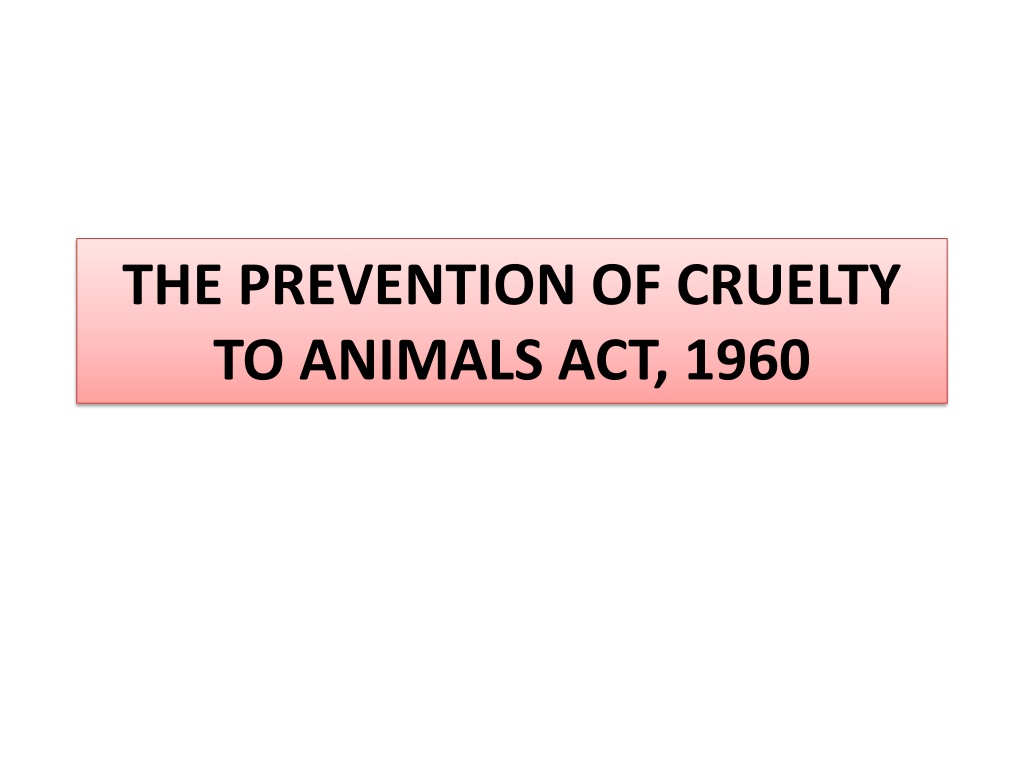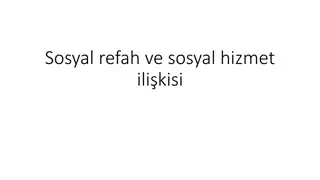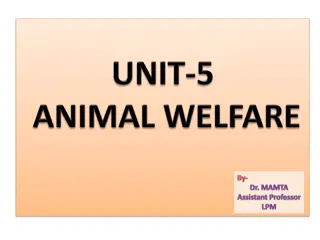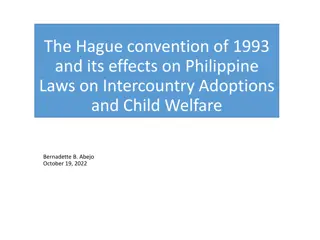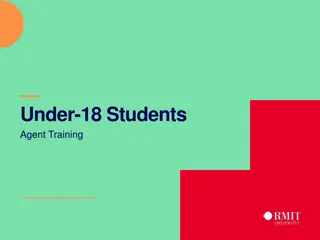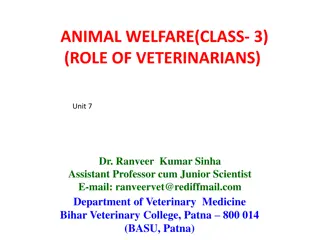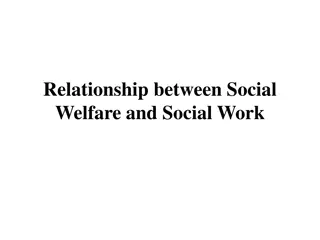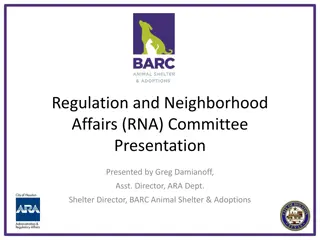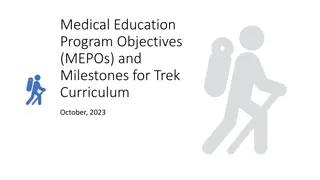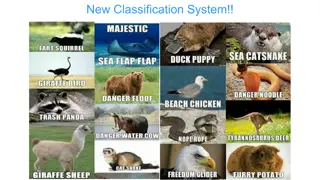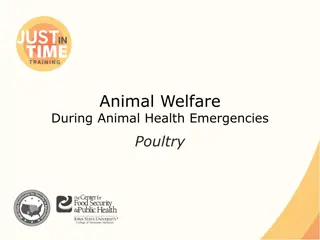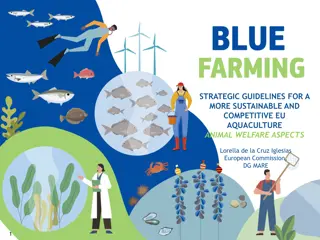Milestones in Animal Welfare: Evolution of Laws and Societal Awareness
The Prevention of Cruelty to Animals Act of 1960 reflects a global movement towards better animal welfare. From historical milestones like the founding of animal protection organizations to recent instances of animal cruelty in India, progress has been made, highlighting the importance of social awareness, stringent laws, and community development for the well-being of animals.
Download Presentation

Please find below an Image/Link to download the presentation.
The content on the website is provided AS IS for your information and personal use only. It may not be sold, licensed, or shared on other websites without obtaining consent from the author. Download presentation by click this link. If you encounter any issues during the download, it is possible that the publisher has removed the file from their server.
E N D
Presentation Transcript
THE PREVENTION OF CRUELTY TO ANIMALS ACT, 1960
Animal welfare The greatness of a nation and its moral progress can be judged by the way its animals are treated. - Mahatma Gandhi (Father of the Nation) Animal welfare denotes to the quality of life that experienced by animals and how well they are coping with their conditions and surroundings. The five freedoms are: Nutrition: freedom from thirst and hunger Environment: freedom from discomfort by providing appropriate shelter Health: freedom from injury and disease by providing proper treatment Behavior: freedom to express their own kind by providing proper facilities Mental state: freedom from fear and mental suffering The terms animal welfare and animal rights used interchangeably Animal welfare refers to the relationship between the human and animal. It also prescribes certain duties for human towards animals. Animal lives are not at the mercy of humans and we must co-exist in peace.
ACTIVITIES RELATED TO AW To protect the rights and to prevent the cruelty to animals Social awareness among people about the rights and welfare of the animals. Requirement of stringent laws to protect the animals and to punish the wrong doers. Community development through various programs to promote animal rights and to reduce animal cruelty. Regulatory- to implement the various provisions of prevention of cruelty to animals act Using animals for the purposes of religious sacrifice or entertainment or for any other activities which amounts to cruelty to animals should be avoided and made punishable under the law. Every such activity should be strictly investigated by the Animal welfare board, Government, courts and NGOs. Developmental- provide financial assistance through AWBI. For construction of shelter house, dispensaries etc. for stray, infirm and abandoned animals Educational- Workshops, seminars, conferences are organized from time to time
MILESTONES IN ANIMAL WELFARE 1822 Led by Richard Martin, British Parliament passes the "Act to Prevent the Cruel and Improper Treatment of Cattle". 1824 Richard Martin, founds the Society for the Prevention of Cruelty to Animals (now the royal society for the prevention of cruelty to animals), the world's first animal protection organization. 1835 Britain passes its first Cruelty to animals act after lobbying from the Society for the Prevention of Cruelty to Animals, expanding existing legislation to protect bulls, dogs, bears, and sheep, and prohibit bear-baiting and cock-fighting 1944 Donald Watson coins the word Vegan"and founds the vegan society in Britain 1876 After lobbying from anti-vivisectionists, Britain passes the Cruelty to animals act, the first piece of national legislation to regulate animal experimentation 1960 Indian parliament passes its first national animal welfare legislation, the prevention of cruelty to animals act
INSTANCES OF ANIMAL CRUELTY IN INDIA Killing Of A Pregnant Elephant In Kerala: In April 2020, a 10 year old female elephant in at Pathanapuram in Kollam district in Kerala was killed by the villagers. A Female Street Dog Was Raped By A Man In Kolkata: In July 2018, 35 years old man from Kolkata was arrested for allegedly having unnatural offence with the dog. Man Had Unnatural Sex With Cows In Vadodara: In January 2018 a man in Vadodara worked as a labour at a cowshed allegedly indulge in the offence of unnatural sex with three cows. Monkeys Were Brutally Killed And Dumped In Rajasthan: In January 2018, 11 monkeys where found killed near the highway in Rajasthan.. Medical Student Threw A Dog Off The Terrace In Chennai: In July 2016, a student from Madha medical College in Chennai, threw a 5 month old dog from the rooftop. As per a report by PETA (People for the ethical treatment of animals), more than 100 million animals suffer and die every year due to the chemical, drug, food, cosmetics and medical experiments.
In 2016, Kerala government carried out a mass killing of stray dogs in the State in order to curb the canine population. Association and groups were formed for the purpose of training children to kill stray dogs and subsidized airguns were made available to the people. Even the business communities promoted the culling process by providing incentives. Involvement of animals in religious practices has led to a conflict between human and animal interests. In the name of religious practices, animals are often subjected to unnecessary pain and suffering. One such controversy came to the fore, with respect to the age-old practice of Jallikattu, in Southern India. It is a traditional bull-taming practice, organized during the festival of Pongal. The exercise involves a challenge wherein, the bull needs to be tamed by humans, using their hands. To make the process even more challenging, the bulls are often pierced and burned to make them more aggressive. In 2017, the Supreme Court, considering the practice as a cruelty to animals, banned it.
The Question Is Not, Can They Reason? Nor, Can They Talk? But, Can They Suffer? 1780In Legislation philosopher Jeremy Bentham argues for better treatment of animals on the basis of their ability to feel pleasure and pain An Introduction to the Principles of Morals and Our sufferings lie on the same footing as to those of the animals surrounding us. Moral obligation upon us to alleviate the pain and suffering of animals The Prevention of Cruelty to Animals Act 1960, was enacted with a similar object, to prevent the infliction of unnecessary pain and suffering on animals. The Act vests every person with the duty to take all reasonable care in order to ensure the welfare of such animals. The Act consists of six chapters and forty-one sections, addressing crucial points, such as cruelty to animals, their training and experimentation.
THE PREVENTION OF CRUELTY TO ANIMALS ACT, 1960 (59 OF 1960) (26 December, 1960) AN ACT Chapter I Preliminary Chapter II Animal welfare board of India Chapter III Cruelty to animals in general Chapter IV Experimentation of animals Chapter V Performing animals Chapter VI Miscellaneous
CHAPTER 1 PRELIMINARY Short title, extent and commencement (1) This Act may be called the Prevention of Cruelty to Animals Act, 1960 (2) It extends to the whole of India except the State of Jammu and Kashmir (3) It shall come into force on such date as the Central Government may, by notification in the official Gazette, appoint, and different dates may be Appointed for different States and for the different Provisions contained in this Act. Definitions 2. In this Act, unless the context otherwise requires,- (a) animal means any living creature other than a human being (b) Board means the Board established under Section 4, and as reconstituted from time to time (c) captiveanimal means any animal (not being a domestic animal) which is in captivity or confinement, whether permanent or temporary, or which is subjected to any appliance of contrivance for the purpose of hindering or preventing its escape from captivity or confinement or which is pinioned or which is or appears to be maimed; Any animal other than domestic animal which is in captivity or confinment or made to prevent its escape
(d) domestic animalmeans any animal which is tamed or which has been or is being sufficiently tamed to serve some purpose for the use of man or which, although it neither has been nor is intended to be so tamed, is or has become in fact wholly or partly tamed; (E) local authority means a municipal committee, district board or other authority for the time being invested by law with the control and administration of any matters within a specified local area; (F) owner used with reference to an animal, includes not only the owner but also any other person for the time being in possession or custody of the animal, whether with or without the consent of the owner. (G) phooka or doomdev includes any process of introducing air or any substance into the female organ of a milch animal with the object of drawing off from the animal any secretion of milk; (H) prescribed means prescribed by rules made under this act; (I) street includes any way, road, lane, square, court, alley, passage or open space, whether a thorough fare or not to which the public have access.
CHAPTER III The Act enumerates different variants of cruelty to animals under Section 11 as the following actions: Beat- Beat, kicks, override, overload, tortures or subject it to unnecessary pain or sufferings Employ diseased animal- Employs in any work any animal which by reason of any disease, wound is unfit to be so employed Injurious drug- Willfully administer any injurious drug or substance to any domestic animal Convey or carry- Carries in a vehicle any animal in such a manner as to subject it to unnecessary pain or sufferings Keeps or confines caged- Keeps any animal in a very small cage as compared to the size of the animal and do not permit the animal a reasonable opportunity for movement Chained-Keeps any animal for unreasonable time chained upon using an unreasonable short and heavy chain Neglect exercise- Being the owner, Neglect to exercise any dog by keeping it chained or in close confinement
Not provide basic needs- Being the owner, Fails to provide animal with sufficient food , drink, shelter Abandon- Without reasonable cause abandon any animal in circumstances which render it likely that it will suffer pain by reason of starvation or thurst, leading to death Owner negligence- Willfully permit any animal of which he is the owner to go at large in any street while the animal is affected with contagious or infectious disease or permit any diseased or disabled animal of which he is the owner to die in any street Sale- Offers for sale any animal which is suffering pain by reason of mutilation, starvation, thirst, overcrowding, or other ill treatment Killing- Mutilate any animal or kill any animal (including stray dogs) by using the method of strychnine injections in the heart or any other unnecessarily cruel manner Confine- Confines any animal in such a manner so as to make it an object of prey for any other animal solely with a view to provide entertainment for other persons Permits or offer any place to be so used for animal fighting or for the purpose of baiting Promote or take part in any shooting competition wherein animal are released from captivity for the purpose of shooting
CRUELTY DOES NOT APPLY TO Dehorning, castration, branding, nose roping, of any animal in the prescribed manner Destruction of stray dogs in lethal chambers or by other method with a minimum of suffering Extermination or destruction of animal under the authority of any law for the time being in force. Any matter dealt with chapter IV or (For the purpose of treating diseases and alleviating sufferings of human beings, animals and plants, experimentation on animals is made lawful under the Act. ) The commission or omission of any act in the course of the destruction or the preparation for destruction of any animal as food for mankind unless such destruction or preparation was accompanied by the infliction of unnecessary pain or sufferings
Cow blowing, Kuhblasen, phooka, or doom dev, is a process used in many countries according to ethnographers, in which forceful blowing of air into a cows vagina (or sometimes anus ) is applied to induce her to produce more milk Cow blowing was the reason why Gandhi abjured cow milk, saying that "since I had come to know that the cow and the buffalo were subjected to the process of phooka, I had conceived a strong disgust for milk." Section 12: penalty for practicing phooka or doom dev- If any person upon any cow or other milch animal the operation called practicing phooka or doom dev or any other operation (including injection of any or doom dev substance) to improve lactation which is injurious to the health of the animals or permits such operation being performed upon any such animal in his possession or under his control, He shall be punishable with fine which may extend to one thousand rupees or with imprisonment for a term which may extend to two years or with both and the animal on which the operation was performed shall be forfeited to the government
Section 13: destruction of suffering animals Where the owner of an animal is convicted of an offence under section 11, It shall be lawful for the court, if the court is satisfied that it would be cruel to keep the animal alive, To direct that the animal be destroyed and to assign the animal to any suitable person for that purpose, And the person to whom such animal is so assigned shall, as soon as possible, destroy such animal or cause such animal to be destroyed in his presence without unnecessary suffering, and Any reasonable expense incurred in destroying the animal may be ordered by the court to be recovered from the owner as if it were a fine: Provided that unless the owner assents thereto, no order shall be made under this section except upon the evidence of a veterinary officer in charge of the area. In order to ensure effective implementation of the provisions of the Act, special powers have been vested with the Police and the Courts. The Police, under this Act, have the authority to seize any animal if they have reason to believe that such animal has been subjected to cruelty or may be subjected to cruelty, and produce it before a magistrate or a veterinary officer for examination. The Courts are empowered by the Act to forfeit an animal to the government, upon the conviction of its owner for an offence committed under the Act. The State Governments are therefore required to appoint infirmaries for the treatment and care of animals, against whom any offence is committed.
LAWS ON GROUND Government Initiatives Ban On Captive Dolphin Shows: In May 2013, the Ministry of Environment & Forest, Government of India, prohibits the capture and use of Dolphins for entertainment purposes in the country. It also issued a policy and directed the state governments to deny the permission to any Dolphinarium. Ban On Imports Of Animal Tested Cosmetics: In Nov, 2014, India became the first South Asian Nation to impose ban on imports of animal tested cosmetics in India. By this bold step India has become the first cruelty-free zone in South Asia.
